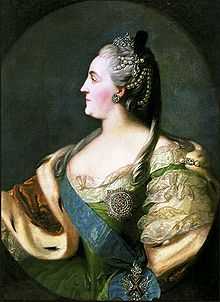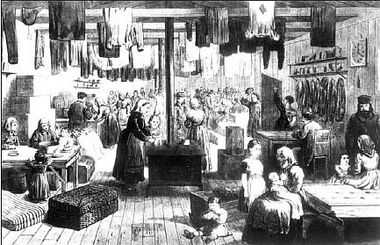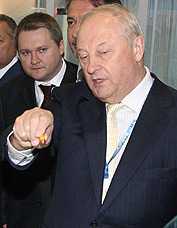Volga Germans

The Volga Germans (German: Wolgadeutsche or Russlanddeutsche, Russian: Поволжские немцы, Povolzhskie nemtsy) were ethnic Germans living along the River Volga in the region of southeastern European Russia around Saratov and to the south. Recruited as immigrants to Russia in the 18th century, they were allowed to maintain their German culture, language, traditions, and churches (Lutheran, Reformed, Catholics, and Mennonites). In the 19th and early 20th centuries, many Volga Germans emigrated to the Dakotas and other states in the western United States, as well as to Canada and South America (mainly Argentina and Brazil).
After the Nazi invasion of the Soviet Union in 1941 during World War II, the Soviet government considered the Volga Germans potential collaborators, and transported many of them eastwards, where thousands died. After the war, the Soviet Union expelled some ethnic Germans to the West. In the late 1980s, many of the remaining ethnic Germans moved from the Soviet Union to Germany.
Catherine the Great

In 1762, Catherine II, born a German princess and a native of Stettin, Pomerania, deposed her husband Peter III (also originally from a Germanic land) and took the Russian imperial throne. Catherine the Great published manifestos in 1762 and 1763 inviting Europeans (except Jews)[1] to immigrate and farm Russian lands while maintaining their language and culture. Although the first received little response, the second improved the benefits offered and was more successful in attracting colonists. People in other countries such as France and England were more inclined to migrate to the colonies in the Americas than to the Russian frontier. Other countries, such as Austria, forbade emigration. The settlers came mainly from Bavaria, Baden, Hesse, the Palatinate, and the Rhineland, over the years 1763 to 1767.
The early German settlements were attacked during the Pugachev uprising, which was centred on the Volga area, but they survived the rebellion. According to Darrel P. Kaiser, "Kazakh-Kirghiz tribesmen kidnapped 1573 settlers from colonies in 1774 alone and only half were successfully ransomed. The rest were killed or enslaved."[2]
Those who went to Russia had special rights under the terms of the manifesto. Some, such as being exempt from military service, were revoked in the latter part of the 19th century when the government needed more conscripts for the Russian army. The German Mennonite communities were opposed to military service because of their pacifist beliefs, so many Mennonites emigrated to the Americas instead.
20th century

Following the Russian Revolution, the Volga German Autonomous Soviet Socialist Republic (Autonome Sozialistische Sowjet-Republik der Wolga-Deutschen in German; АССР Немцев Поволжья in Russian) was established in 1924, and it lasted until 1941. Its capital was Engels, known as Pokrovsk (Kosakenstadt in German) before 1931.
When Nazi Germany invaded the Soviet Union in 1941, Stalin was worried that the Volga Germans might collaborate with the invaders. On August 28, 1941, he dissolved the Volga-German ASSR and ordered the immediate relocation of ethnic Germans, both from the Volga and from a number of other traditional areas of settlement. About 400,000 Volga Germans were stripped of their land and houses, and transported eastward to Kazakhstan in Soviet Central Asia, Altai Krai in Siberia, and other remote areas. In 1942, nearly all the able-bodied German population was conscripted to the NKVD labor columns. About one-third did not survive the camps.[3]
In 1941 after the Nazi invasion, the NKVD (via Prikaz 35105) banned ethnic Germans from serving in the Soviet military. They sent tens of thousands of these soldiers to the Trudarmii (Labour Army).[4]
Recent years

The Volga Germans never returned to the Volga region in their old numbers. They were not allowed to settle in the area for decades.. After the war, many remained in the Ural Mountains, Siberia, Kazakhstan (1.4% of today's Kazakh population are recognized as Germans - around 200,000), Kyrgyzstan, and Uzbekistan (about 16,000 = 0.064%).[5] After the initial period of persecution, they recovered in their new locations, where their numbers increased, and they continued to preserve their distinct cultural identity. Decades after the war, some talked about resettling where the German Autonomous Republic used to be. They met opposition from the population that had been resettled in the territory and did not persevere.

A proposal in June 1979 called for a new German Autonomous Republic within Kazakhstan, with a capital in Ermentau. The proposal was aimed at addressing the living conditions of the displaced Volga Germans. At the time, around 936,000 ethnic Germans were living in Kazakhstan, as the republic's third-largest ethnic group. On June 16, 1979, demonstrators in Tselinograd (Astana) protested this proposal. Fearing a negative reaction among the majority Kazakhs and calls for autonomy among local Uyghurs, the ruling Communist Party scrapped the proposal for ethnic German autonomy within Kazakhstan.
Since the late 1980s and the fall of the Soviet Union, some ethnic Germans have returned in small numbers to Engels, but many more emigrated permanently to Germany. They took advantage of the German law of return, a policy which grants citizenship to all those who can prove to be a refugee or expellee of German ethnic origin or as the spouse or descendant of such a person. (Greece had a similar law for the ethnic Greek minority from the former Soviet Union). This exodus occurred, although some Volga Germans speak little or no German.
Since the collapse of the Soviet Union in 1991 and the independence of the Baltic states, some Russian ethnic Germans began to return to the area of the Kaliningrad Oblast (formerly part of East Prussia), especially Volga Germans from other parts of Russia and Kazakhstan. This tempo increased after Germany stopped granting the free right of return to ethnic Germans from the former Soviet Union. As of the 2002 Russian census, 8,340 Germans (or 0.87% of the population) were listed in the Kaliningrad Oblast. However, almost none of the pre-World War II German population remains in the Kaliningrad Oblast.
By the late 1990s, however, Germany made it more difficult for Russians of German descent to settle in Germany, especially for those who do not speak some of the Volga dialects of German. A number of German families who originally migrated to Germany from former Soviet territories have since moved on to places such as Steinbach, Manitoba, fewer than 100 km from Winnipeg, where the world's largest population of ethnic German Mennonites can be found.
Today, about 600,000 ethnic Germans are in Russia (Russian Census (2002)), a number that increases to 1.5 million when including people of partly German ancestry.
North America

Germans from Russia were the most traditional of German-speaking arrivals. They were Germans who had lived for generations throughout the Russian Empire, but especially along the Volga River in Russia. Their ancestors had come from all over the German-speaking world, invited by Catherine the Great in 1762 and 1763 to settle and introduce more advanced German agriculture methods to rural Russia. They had been promised by the manifesto of their settlement the ability to practice their respective Christian denominations, retain their culture and language, and retain immunity from conscription for them and their descendants. As time passed, the Russian monarchy gradually eroded the ethnic German population's relative autonomy. Conscription eventually was reinstated; this was especially harmful to the Mennonites, who practice pacifism. Throughout the 19th century, pressure increased from the Russian government to culturally assimilate. Many Germans from Russia found it necessary to emigrate to avoid conscription and preserve their culture. About 100,000 immigrated by 1900, settling primarily in the Dakotas, Kansas, and Nebraska. The south-central part of North Dakota was known as "the German-Russian triangle". A smaller number moved farther west, finding employment as ranchers and cowboys.
The largest groups settled mainly in the area of the Great Plains: Alberta, Manitoba, and Saskatchewan in Canada; and North Dakota, Nebraska, Kansas, and nearby areas in the US. Outside that area, they also settled in Iowa, Michigan, Minnesota, New York, Oregon, Washington, Wisconsin, and Fresno County in California's Central Valley. They often succeeded in dryland farming, which they had practiced in Russia. Many of the immigrants who arrived between 1870 and 1912 spent a period doing farm labour, especially in northeastern Colorado and in Montana along the lower Yellowstone River in sugar beet fields.
South America
Germans from Russia also settled in Argentina (see Crespo and Coronel Suárez among others, also German Argentine), Paraguay, and Brazil (see German-Brazilians). Most Volga Germans who settled in Latin America were Catholic. Many Catholic Volga Germans chose South America as their new homeland because the nations shared their religion.
Notable people of Volga German descent
- Harold W. Bauer, USMC aviator
- Tom Daschle, politician
- Viktor Kress, governor of Tomsk Oblast, Russia
- Jean Bethke Elshtain, professor
- Zhanna Friske, singer
- Gil Friesen, entertainment industry executive
 Eduard Rossel was the governor (1995 - 2009) of Sverdlovsk Oblast, Russia.
Eduard Rossel was the governor (1995 - 2009) of Sverdlovsk Oblast, Russia. - Andre Geim, physicist and 2010 Nobel laureate
- Jim Geringer, politician
- German Gref, banking executive and politician
- Gabriel Heinze, football player
- Óscar Ibáñez, football player
- Boris Rauschenbach, scientist, physicist
- Eduard Rossel, politician
- Alfred Schnittke, composer
- Philip Anschutz, businessman
- Helene Fischer, singer
See also

- Expulsion of Germans after World War II
- Germans of Kazakhstan
- Gulag
- History of Germans in Russia and the Soviet Union
- Volga German Autonomous Soviet Socialist Republic
- Volhynia
- Russian Mennonites
- Volga Finns
- Baltic Germans
References
- ↑ Lewis, Bernard, Semites and Anti-Semites, New York, W. W. Norton & Company, 1999 edition, ISBN 0-393-31839-7, p. 61.
- ↑ Darrel P. Kaiser (2006). Origin & Ancestors Families Karle & Kaiser Of the German-Russian Volga Colonies. Darrel P. Kaiser. ISBN 978-1-4116-9894-9. Retrieved May 31, 2012.
- ↑ Robert Conquest, The Nation Killers (Macmillan, 1970), pages 59-61.
- ↑ J. Otto Pohl, Ethnic cleansing in the USSR, 1937-1949, Greenwood Publishing Group, via books.google.com, accessed 12 October 2010
- ↑ Stat.kz
External links
- The Center for Volga German Studies at Concordia University
- Germans from Russia Heritage Society
- Flag
- Volga Germans
- American Historical Society of Germans from Russia
- Germans from Russia Heritage Collection North Dakota State University
- Germans from Russia in Argentina Genealogy (Spanish)
- Wolgadeutschen (Russian)
- The Golden Jubilee of German-Russian Settlements of Ellis and Rush Counties, Kansas
- Germans from Russia in Argentina
- German Memories - Volga Germans Migration Towards Americas
| ||||||||||||||||||||||||||||||||||||||||||||||||||||||